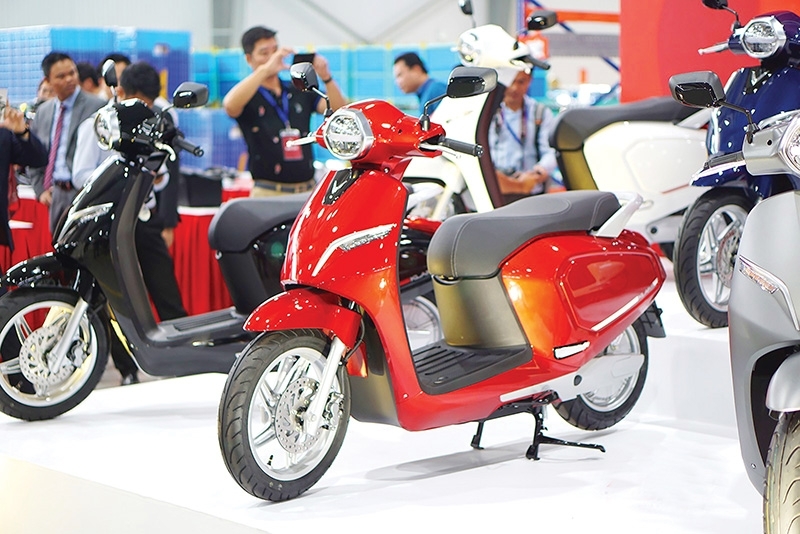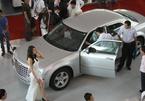 |
|
VinFast continues to push its range of motorbike models with new initiatives and promotions for consumers to save money in the long-term. Photo Le Toan |
Truong Hai Auto Corporation (THACO) last week announced the arrival of THACO Motorcycle Manufacturing Llc., which is to be based in Chu Lai Economic Zone in the central province of Quang Nam.
The new entity boasts charter capital of VND10 billion ($433,000) and has been registered to produce and sell both motorbikes and their parts.
The main THACO group manufactures trucks and public transport buses, and also assembles cars for Peugeot, Kia, and Mazda.
THACO’s motorbike move is a shift into a crowded market led by foreign giants. The Vietnamese two-wheeler industry is the fourth-largest in the world, dominated by the five main producers of Honda, Yamaha, Suzuki, SYM, and Piaggio. In total, the five sold over 3.2 million motorcycles last year, with Honda selling 2.57 million units, up 0.2 per cent on-year, leading the market share.
Newcomers are also trying to elbow their way into the fray. Just one year after the opening ceremony for VinFast’s electric motorcycle manufacturing factory took place, the group announced that 50,000 electric motorbikes were sold last year, featuring the models Klara, Klara S, Impes, and Ludo.
Meanwhile, the locally-invested electric newcomer Pega has been biting at the heels of Honda in an attempt to gain some notoriety as a motorbike company upstart.
Last month, Honda threatened to take Pega to court as the Vietnamese group used comparative marketing strategies between the new Pega eSH and Honda’s SH 2020 at a presentation without permission to use Honda’s images or product details.
In response, Pega director Doan Ngoc Linh posted a “letter of intent” on his personal Facebook page, outlining a number of supposed problems with Honda products and offering advice on what the motorbike giant should do in order to improve.
Linh also revealed he had sent a crate of Wake-Up 247 coffee energy drink, implying that Honda should “wake up” and create better breakthrough innovations for its customers.
Taking on Goliath
Pega’s tactics have raised eyebrows in the industry, but they illustrate the stranglehold Honda has had on the Vietnamese motorbike realm over the last few decades, and domestic groups are intent on thinking outside the box in order to grasp some sort of slice of the industry cake.
After more than 20 years and with three factories, Honda Vietnam currently holds a massive 70 per cent of Vietnamese market share, and its sales now make up around 10 per cent of Honda’s annual global motorcycle sales.
Since its establishment in 1996 in Vietnam, the company has invested about $530 million into the country, delivering over 20 million motorcycles and 50,000 automobiles to Vietnamese customers. It is reported that Honda Vietnam has earned some VND7.6 trillion ($330.43 million) a month. Thus it is clear that what the company has earned has been far higher than what it has invested in Vietnam.
As for Pega, after five years in the electric bike market and big product launches in 2017, it is still trying to make its mark via a patriotic mindset with wholly-Vietnamese designs, as well as attempting to get under the skin of bigger dogs like Honda.
Pega has only one electric vehicle assembly factory, in the northern province of Bac Giang, with designed capacity of 40,000 vehicles per month, as well as 250 showrooms and 500 second-level stores.
Despite facing criticism from some quarters for using underhanded marketing campaigns, CEO Linh remains confident of his intentions. “Difficulties are opportunities, and we are not afraid to compete with giants,” he insisted, pointing out last month that company rivalries and product comparisons were par for the course and his group would continue to make them.
Pega had also previously been in a skirmish with Piaggio, which accused the former of spreading untruths about their fuel-based products in comparison to electric-based equivalents.
Pega is competing directly with Honda’s SH scooter, which is available in two versions and is considered the current king of high-end scooters in the Vietnamese market. Prices for Honda’s SH range from VND70 million ($3,000) to VND121 million ($5,250), while Pega’s electric eSH scooter was launched with the competitive price of VND30 million ($1,300).
Industry expert Vu Tan Cong said that switching from fuel-powered vehicles to electric equivalents is a rising trend that will be further developed with government support. Besides coping with climate change, the expanding field of e-mobility can lead to innovative technologies, new business models, and new consumer structures, and eventually to new patterns of mobility and traffic.
Domestic upstarts
At a cost of only 50 per cent compared to the same type of gasoline motorcycle used after five years, e-bikes such as VinFast Klara may become the most effective products to invest in.
More specifically, when comparing annual consumption, with battery charge from VND220,000-350,000 ($9.50-15) each month, repair, and maintenance costs are estimated to be half as cheap as conventional cars.
Klara is also popular with younger people because of its dynamism and eye-catching Italian design. VinFast has also focused on its technology being completely integrated with phones so that customers can check their vehicle location and battery life.
To further ease use for customers as well as to increase its presence in the market, VinFast last week announced provision of additional battery chargers for its e-models at a cost of VND1.1 million ($48).
For the latest generation of the Klara S, Impes, and Ludo, each month customers will pay VinFast a subscription fee of VND220,000 for one battery, or VND350,000 for two Klara S batteries. As a result, the cost of the original vehicle is reduced, and the customer also does not bear risk during use. If the battery is damaged, VinFast will be held responsible for replacing them.
Global management consultants McKinsey & Company stressed that governments are tightening regulations and offering incentives to foster greater electric vehicle adoption.
In the EU for example, a new set of fleet-wide CO2 targets will be phased in this year. Original equipment manufacturers need to fully comply with an industry-wide emissions target for CO2 of 95 grammes per kilometre by 2021 to avert significant financial penalties. These mandates are putting additional pressure on such groups to push electric vehicles further into the market.
Under Vietnam’s commitments, the country seeks to cut 8 per cent of greenhouse gas emissions by 2030, which could be raised to as high as 25 per cent with support from the international community. In Vietnam, motorbikes are the main means of transportation in the major cities, currently responsible for about 80 per cent of travel needs. VIR
Nguyen Thu

Fewer motorcycles purchased locally in 2019
The consumption of motorcycles on the local market amounted to over three million units last year, down 3.8% against 2018.

When will the Vietnamese automobile dream come true?
Vietnam still has to import car parts for domestic assembling. As a result, the production cost is high and domestically made products remain less competitive than imports.
 One of the leading car manufacturers in Vietnam is moving into the light motorcycle market, lending more sparks to the fire that is Vietnam’s heated two-wheeler arena.
One of the leading car manufacturers in Vietnam is moving into the light motorcycle market, lending more sparks to the fire that is Vietnam’s heated two-wheeler arena.